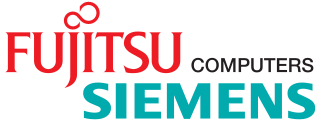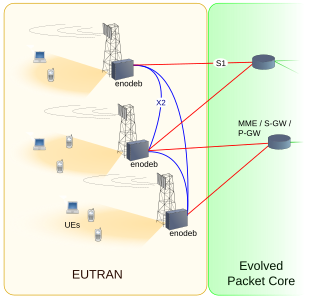Related Research Articles

Nokia Corporation is a Finnish multinational telecommunications, information technology, and consumer electronics corporation, originally established as a pulp mill in 1865. Nokia's main headquarters are in Espoo, Finland, in the Helsinki metropolitan area, but the company's actual roots are in the Tampere region of Pirkanmaa. In 2020, Nokia employed approximately 92,000 people across over 100 countries, did business in more than 130 countries, and reported annual revenues of around €23 billion. Nokia is a public limited company listed on the Nasdaq Helsinki and New York Stock Exchange. It was the world's 415th-largest company measured by 2016 revenues, according to the Fortune Global 500, having peaked at 85th place in 2009. It is a component of the Euro Stoxx 50 stock market index.

A content delivery network or content distribution network (CDN) is a geographically distributed network of proxy servers and their data centers. The goal is to provide high availability and performance ("speed") by distributing the service spatially relative to end users. CDNs came into existence in the late 1990s as a means for alleviating the performance bottlenecks of the Internet as the Internet was starting to become a mission-critical medium for people and enterprises. Since then, CDNs have grown to serve a large portion of the Internet content today, including web objects, downloadable objects, applications, live streaming media, on-demand streaming media, and social media sites.

Fujitsu Siemens Computers GmbH was a Japanese and German vendor of information technology. The company was founded in 1999 as a 50/50 joint venture between Fujitsu of Japan and Siemens AG of Germany. On April 1, 2009, the company became Fujitsu Technology Solutions as a result of Fujitsu buying out Siemens' share of the company.

E-UTRA is the air interface of 3rd Generation Partnership Project (3GPP) Long Term Evolution (LTE) upgrade path for mobile networks. It is an acronym for Evolved UMTS Terrestrial Radio Access, also known as the Evolved Universal Terrestrial Radio Access in early drafts of the 3GPP LTE specification. E-UTRAN is the combination of E-UTRA, user equipment (UE), and a Node B.
Nokia Networks is a multinational data networking and telecommunications equipment company headquartered in Espoo, Finland, and wholly owned subsidiary of Nokia Corporation. It started as a joint venture between Nokia of Finland and Siemens of Germany known as Nokia Siemens Networks.

Emirates Integrated Telecommunications Company P.J.S.C., commercially rebranded as du (دو) in February 2007, is one of the two main telecom operators in the United Arab Emirates. du offers fixed line, mobile telephony, internet and digital television services across the UAE. It also provides carrier services, a data hub, internet exchange facilities and satellite service for broadcasters. It expanded its services in support of economic and social transformation of UAE and operates subsidiaries such as EITC Investment Holdings Limited, Edara, Smart Dubai Platform Project Company LLC and EITC Singapore PTE. LTD.
Mobile device management (MDM) is the administration of mobile devices, such as smartphones, tablet computers, and laptops. MDM is usually implemented with the use of a third-party product that has management features for particular vendors of mobile devices. Though closely related to Enterprise Mobility Management and Unified Endpoint Management, MDM differs slightly from both: unlike MDM, EMM includes mobile information management, BYOD, mobile application management and mobile content management, whereas UEM provides device management for endpoints like desktops, printers, IoT devices, and wearables as well.

LTE Advanced is a mobile communication standard and a major enhancement of the Long Term Evolution (LTE) standard. It was formally submitted as a candidate 4G to ITU-T in late 2009 as meeting the requirements of the IMT-Advanced standard, and was standardized by the 3rd Generation Partnership Project (3GPP) in March 2011 as 3GPP Release 10.
In telecommunications, long-term evolution (LTE) is a standard for wireless broadband communication for mobile devices and data terminals, based on the GSM/EDGE and UMTS/HSPA standards. It improves on those standards' capacity and speed by using a different radio interface and core network improvements. LTE is the upgrade path for carriers with both GSM/UMTS networks and CDMA2000 networks. Because LTE frequencies and bands differ from country to country, only multi-band phones can use LTE in all countries where it is supported.
Flat IP architecture refers to a network design that uses a single level of communication instead of the hierarchical structure layouts that is commonly used with traditional IP addresses.
Continuous Computing was a privately held company based in San Diego and founded in 1998 that provides telecom systems made up of telecom platforms and Trillium software, including protocol software stacks for femtocells and 4G wireless / Long Term Evolution (LTE). The company also sells standalone Trillium software products and ATCA hardware components, as well as professional services. Continuous Computing's Trillium software addresses LTE Femtocells and pico / macro eNodeBs, as well as the Evolved Packet Core (EPC), Mobility Management Entity (MME), Serving Gateway (SWG) and Evolved Packet Data Gateway (ePDG).
Mobile data offloading is the use of complementary network technologies for delivering data originally targeted for cellular networks. Offloading reduces the amount of data being carried on the cellular bands, freeing bandwidth for other users. It is also used in situations where local cell reception may be poor, allowing the user to connect via wired services with better connectivity.
Sony Semiconductor Israel Ltd., formerly known as Altair Semiconductor, is an Israeli developer of high performance single-mode Long Term Evolution (LTE) chipsets. The company's product portfolio includes baseband processors, RF transceivers and a range of reference hardware products. Founded in 2005, Altair employs 190 employees in its Hod Hasharon, Israel headquarters and R&D center, and has regional offices in the United States, Japan, China, India, Finland, and France. Altair Semiconductor was the first chipset vendor to receive certification from Verizon Wireless to run on its 4G LTE network. Altair has also powered several devices launched on Verizon's network including the Ellipsis 7 tablet and HP Chromebook 11.6"LTE. In January 2016, it was announced that Sony was acquiring Altair for $212 Million. Altair was renamed Sony Semiconductor Israel on March 29, 2020.
Access network discovery and selection function (ANDSF) is an entity within an evolved packet core (EPC) of the system architecture evolution (SAE) for 3GPP compliant mobile networks. The purpose of the ANDSF is to assist user equipment (UE) to discover non-3GPP access networks – such as Wi-Fi or WIMAX – that can be used for data communications in addition to 3GPP access networks and to provide the UE with rules policing the connection to these networks.
Software-defined networking (SDN) is an approach to network management that uses abstraction to enable dynamic and programmatically efficient network configuration to create grouping and segmentation while improving network performance and monitoring in a manner more akin to cloud computing than to traditional network management. SDN is meant to improve the static architecture of traditional networks and may be employed to centralize network intelligence in one network component by disassociating the forwarding process of network packets from the routing process. The control plane consists of one or more controllers, which are considered the brains of the SDN network, where the whole intelligence is incorporated. However, centralization has certain drawbacks related to security, scalability and elasticity.
Network functions virtualization (NFV) is a network architecture concept that leverages IT virtualization technologies to virtualize entire classes of network node functions into building blocks that may connect, or chain together, to create and deliver communication services.
Multi-access edge computing (MEC), formerly mobile edge computing, is an ETSI-defined network architecture concept that enables cloud computing capabilities and an IT service environment at the edge of the cellular network and, more in general at the edge of any network. The basic idea behind MEC is that by running applications and performing related processing tasks closer to the cellular customer, network congestion is reduced and applications perform better. MEC technology is designed to be implemented at the cellular base stations or other edge nodes, and enables flexible and rapid deployment of new applications and services for customers. Combining elements of information technology and telecommunications networking, MEC also allows cellular operators to open their radio access network (RAN) to authorized third parties, such as application developers and content providers.

Airtel India is the second largest provider of mobile telephony and third largest provider of fixed telephony in India, and is also a provider of broadband and subscription television services. The brand is operated by several subsidiaries of Bharti Airtel, with Bharti Hexacom and Bharti Telemedia providing broadband fixed line services and Bharti Infratel providing telecom passive infrastructure service such as telecom equipment and telecom towers. Currently, Airtel provides 5G, 4G and 4G+ services all over India. Currently offered services include fixed-line broadband, and voice services depending upon the country of operation. Airtel had also rolled out its VoLTE technology across all Indian telecom circles.

MikroTik is a Latvian network equipment manufacturing company. MikroTik develops and sells wired and wireless network routers, network switches, access points, as well as operating systems and auxiliary software. The company was founded in 1996, and as of 2022, it was reported that the company employed 351 employees.
References
- ↑ Nokia MSC Server System White Paper
- ↑ "TAS, Telecom Application Server". Nokia Networks. 6 February 2017. Retrieved 22 April 2017.
- ↑ Functional regression testing and test automation in a 3G network element platform environment
- ↑ uniteChannel (2 June 2015), Liquid Core: Nokia telco cloud in action, archived from the original on 13 December 2021, retrieved 22 April 2017
- ↑ "MBB Liquid Core | Nokia Wrocław". nokiawroclaw.pl. Archived from the original on 22 June 2015.
- ↑ "Nokia CloudBand". Nokia Networks. 25 March 2013. Retrieved 22 April 2017.
- ↑ Knut Holt Market Oriented Product Innovation: A Key to Survival in the Third Millennium
- ↑ Automaattisten puhelinkeskusten historia (in Finnish)
- 1 2 Robert J. Chapuis 100 Years of Telephone Switching
- ↑ OVERCOMING A TECHNOLOGICAL DISCONTINUITY The case of the Finnish telecom industry and the GSM
- ↑ Press release: Nokia supplies advanced Fixed Mobile Convergence solutions to Saunalahti in Finland
- ↑ http://nsn.com/news-events/press-room/press-releases/nokia-siemens-networks-rings-up-another-first-in-lte-with-3gpp Nokia Siemens Networks rings up another first in LTE with 3GPP standardized voice calls
- ↑ http://nsn.com/news-events/press-room/press-releases/nokia-siemens-networks-surges-ahead-with-telco-cloud-technology Nokia Siemens Networks surges ahead with Telco Cloud technology